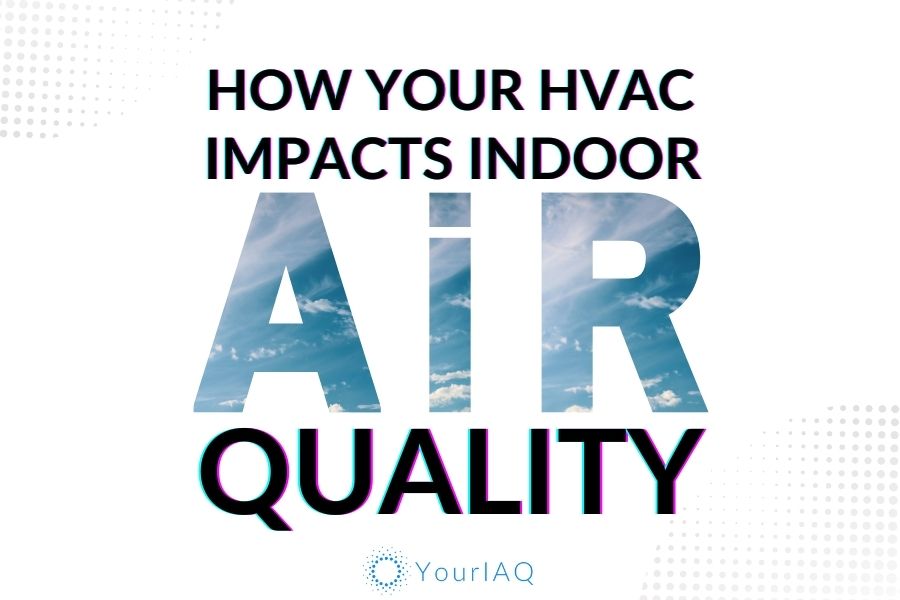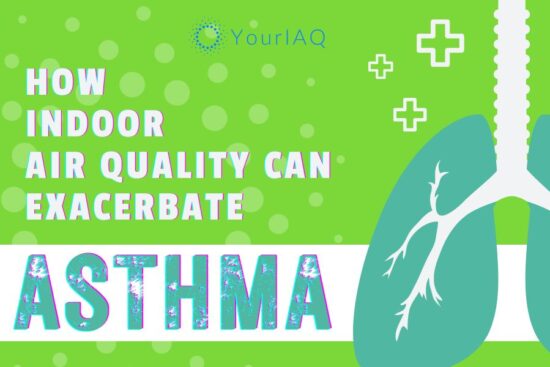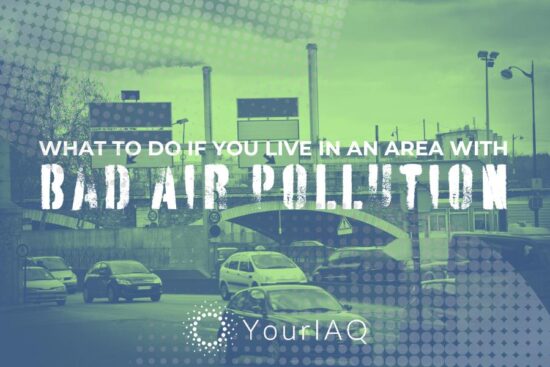
Have you ever wondered why your allergies flare up indoors or why you feel tired and sluggish at home? The culprit might be closer than you think – your HVAC system. While its primary function is temperature control, your HVAC plays a vital role in managing your indoor air quality (IAQ), silently impacting your health and comfort.
This article dives into the various components of a typical home HVAC system—your furnace, air conditioner, fans, ventilation, and air filters—and elucidates their impact on IAQ.
HVAC and Indoor Air Quality: The Hidden Link
Think of your HVAC system as an orchestra, with each component playing its part in the symphony of your home’s air:
Furnace/Boiler
At its core, the furnace or boiler in your HVAC system acts as the heart of home heating, pumping warmth throughout your living spaces during the cooler months. Furnaces generate warm air, while boilers produce hot water or steam for heating.
Fuel Types and Their Impact
Furnaces and boilers run on various fuel sources, including natural gas, oil, electricity, or propane. Accordingly, the choice of fuel has a significant impact on both the efficiency of your heating system and the indoor air quality of your home.
Natural Gas
Natural gas is the most common fuel source for modern furnaces. It is efficient and has a lower environmental impact compared to oil or coal.
Impact: Combustion releases small amounts of nitrogen dioxide (NO2, a respiratory irritant), carbon monoxide (CO), and particulate matter into your home, especially if the system is not properly vented or maintained.
FACTAccording to the Centers for Disease Control and Prevention (CDC), Carbon Monoxide (CO) poisoning is responsible for over 420 deaths annually. CO is a colorless, odorless gas that is deadly at high levels. |
Oil
Oil furnaces are less common than gas furnaces and require a storage tank and regular deliveries.
Impact: Produce more soot and sulfur dioxide.
Electricity
Electric furnaces and boilers don’t produce combustion pollutants since there’s no burning of fuel. This makes them an appealing option for homeowners concerned about indoor air quality.
Impact: Expensive to operate (depending on local electricity rates).
Propane
Propane is an option where natural gas isn’t available. It burns cleaner than oil but still requires careful handling and ventilation.
Air Conditioner
Essentially, an air conditioner removes heat from your home and expels it outside, cooling your space and lowering humidity. This reduction in humidity not only cools but also makes the indoor environment more comfortable
However, the very process that makes air conditioners beneficial also poses a risk to indoor air quality: mold growth.
How AC coils affect indoor air quality (IAQ)
Air conditioners naturally create condensation as they cool the air. The coils, both evaporator and condenser, play a key role in the heat exchange process. Over time, they accumulate dust, dirt, and other debris, which can:
- Reduce Efficiency: Dirty coils can’t transfer heat as effectively, meaning your AC has to work harder to cool your home, leading to increased energy consumption and higher bills.
- Promote Mold Growth: The debris retains moisture, providing an ideal environment for mold to grow and thrive.
- Affect Indoor Air Quality: As airflow passes over dirty coils, it picks up and circulates contaminants throughout your home.
Mold spores can then be released back into your home through the air vents, triggering allergies, respiratory issues, and even asthma attacks. A study published in the Journal of Allergy and Clinical Immunology found that exposure to indoor mold was associated with a 35% increased risk of asthma development in children.
Look out for these common mold symptoms: Coughing, sneezing, sore throats, and in more severe cases, exacerbation of asthma or other respiratory conditions.
Pro tips to prevent molds:
- The Environmental Protection Agency (EPA) recommends professional cleaning at least once a year.
- Invest in a programmable thermostat to maintain consistent humidity levels.
- Replace or clean your AC’s air filter according to the manufacturer’s recommendations, typically every 30 to 90 days.
- Ensure the AC unit’s drain pan and line are clear of clogs to prevent water buildup.
Related reading: Mold Hotspots: Ranking the 5 Worst U.S. States for Mold
Fans and Ducts
Ceiling Fans
Ceiling fans are the conductors of air, orchestrating air movement to make rooms feel cooler in summer and warmer in winter. By circulating air, they reduce the reliance on air conditioning and heating, potentially lowering energy bills.
Tip: The American Lighting Association notes that the use of ceiling fans allows for raising the thermostat setting about 4°F with no reduction in comfort during the cooling season.
Exhaust Fans
Primarily found in bathrooms and kitchens, exhaust fans play a critical role in removing excess humidity and odors. They help prevent mold growth and maintain air quality by venting polluted air outside.
Ducts
Ducts distribute conditioned air efficiently and evenly. Leaky ducts can be disastrous, allowing unconditioned air, dust, and even pests to enter, compromising your IAQ.
Leaks also mean that ducts lose 20 to 30% of the air that moves through them, as estimated by the U.S. Department of Energy. This not only compromises your home’s comfort but also skyrockets energy bills and strains your HVAC system.
What to do when there is a leak
Seal ducts to prevent dust, insulation particles, and fumes from entering and circulating through your home. The EPA recommends hiring professionals for duct improvement projects to ensure that duct sealing is effectively and safely conducted.
Ventilation
Ventilation plays a crucial role in maintaining IAQ by introducing fresh air into your home and expelling stale, contaminated air. There are mainly two types of ventilation systems: natural and mechanical.
Natural ventilation
Natural Ventilation leverages windows, doors, and vents to allow air to flow naturally into a space. It’s an effective way to reduce energy costs and improve air quality by diluting indoor pollutants. However, its effectiveness varies significantly with weather conditions, outdoor air quality, and building design.
Mechanical ventilation
Mechanical Ventilation systems, on the other hand, use fans and ducts to provide controlled air exchange. Unlike natural ventilation, mechanical systems can filter, dehumidify, and precondition the incoming air, offering a more consistent solution for IAQ.
Examples include exhaust fans in bathrooms and kitchens that remove contaminants directly from their source.
Energy recovery ventilation (ERV)
An advanced and highly efficient option within mechanical ventilation systems is the Energy Recovery Ventilator (ERV). ERVs not only exchange indoor and outdoor air but also transfer moisture and heat from the outgoing air to the incoming air, reducing the energy required to heat or cool the building.
The U.S. Environmental Protection Agency (EPA) highlights the importance of proper ventilation in maintaining healthy IAQ, noting that ERVs are beneficial in areas with extreme climates, as they pre-condition the incoming air, making it easier to maintain comfortable indoor temperatures without overburdening the HVAC system.
According to studies, buildings with ERVs not only have better air quality but also consume less energy, aligning with the global push towards energy efficiency and environmental conservation.
Learn more: Ventilation and Purification: 2 Keys to Healthy Indoor Air
Air Filtration
Air filters are the unsung heroes of the HVAC system, playing a pivotal role in maintaining indoor air quality (IAQ) by trapping pollutants such as dust, pollen, mold spores, and pet dander.
Their efficiency in capturing these contaminants is often measured by the Minimum Efficiency Reporting Value (MERV), a rating system developed by The American Society of Heating, Refrigerating, and Air-Conditioning Engineers (ASHRAE), with ratings ranging from 1 to 20. The higher the MERV rating, the finer the filtration, allowing for the capture of smaller particles.
Types of Air Filters:
Fiberglass Filters
These are the most basic and cost-effective options, with lower MERV ratings, typically between 1 and 4. They are designed to protect HVAC equipment rather than improve IAQ.
Pleated Media Filters
Offering a MERV rating of 5 to 13, these filters strike a balance between cost and efficiency, capturing most of the larger airborne particles without significantly restricting airflow.
HEPA Filters
High Efficiency Particulate Air (HEPA) filters boast MERV ratings of 17 to 20. They are the gold standard in filtration, capable of trapping 99.97% of particles that are 0.3 microns or larger. HEPA filters are especially beneficial in homes with allergy sufferers, asthmatics, or those with other respiratory conditions.
Carbon Filters
These capture odors and volatile organic compounds (VOCs) alongside dust and allergens. Carbon filters are beneficial for homes with pets, smoking, or strong cooking smells.
Choosing the Right Filter
Choose the right filter based on your needs. If you have allergies or asthma and pets in the household, consider a higher MERV rating (13-16) while consulting your doctor for optimal selection.
For general use, a MERV rating of 8 to 13 is recommended, as it provides a good balance between filtration efficiency and airflow without overburdening the HVAC system.
Warning Signs of Poor IAQ
Warning signs of poor Indoor Air Quality (IAQ) are often subtle yet significantly impact health and comfort within your home.
Recognizing these signs is crucial for taking timely action to address potential issues with your HVAC system that may be contributing to degraded air quality.
Common Symptoms of Poor IAQ:
- Dust Buildup: Excessive dust accumulation on surfaces shortly after cleaning indicates poor air filtration or leaks in ductwork, allowing unfiltered air into the home.
- Musty Odors: Persistent musty smells suggest mold or mildew growth within the HVAC system, particularly in areas where moisture accumulates, such as air conditioning coils or ducts.
- High Humidity: If your indoor air feels excessively humid, this can promote the growth of mold and other biological pollutants.
- Allergy Flare-ups: An increase in allergy symptoms, such as sneezing, coughing, or itchy eyes while indoors, are signs of allergens like pollen, pet dander, or dust mites being circulated by the HVAC system.
- Headaches, Fatigue, and Respiratory Issues: These are triggered by poor IAQ, resulting from volatile organic compounds (VOCs), carbon monoxide, or other particulates not being adequately filtered out.
The Environmental Protection Agency (EPA) and the American Lung Association highlight the importance of good IAQ, noting that poor indoor air quality leads to long-term health issues such as respiratory diseases, heart disease, and cancer.
Identifying and addressing the signs of poor IAQ early prevents these health issues and improves the overall comfort and safety of your indoor environment.
5 Tips for Maintaining Your HVAC
Maintaining your HVAC system is essential for ensuring good indoor air quality (IAQ) and the overall health and comfort of your home environment.
Here are some practical DIY maintenance tips for key components, alongside the importance of professional inspections and tune-ups.
1. Regular Change of Filters
Regularly replacing the air filters in your HVAC system is one of the simplest yet most effective ways to maintain good IAQ. Experts recommend changing filters every 90 days or more frequently if you have pets or allergies.
HEPA filters or those with higher MERV ratings can capture finer particles, further improving air quality.
2. Clean AC Coils
The coils in your air conditioner and heat pump collect dust and debris, which can reduce efficiency and air quality. Cleaning these coils annually, preferably in the spring, ensures your system operates efficiently and maintains clean air circulation.
Use a soft brush or a coil cleaner, following the manufacturer’s instructions to avoid damage.
3. Inspecting Ductwork
Leaky or dirty ducts can significantly degrade IAQ by distributing pollutants throughout your home. Visually inspect accessible ducts for leaks, and seal them with mastic tape or duct sealant. Consider professional cleaning if you notice significant dust buildup or mold growth.
4. Use a Hygrometer to Monitor Humidity Levels
Use a Hygrometer to check your home’s humidity levels, aiming for a healthy range between 30-50%. Dehumidifiers or humidifiers help maintain optimal levels, preventing mold growth and respiratory issues.
5. Professional Tune-ups and Inspections
Annual or semi-annual inspections by certified technicians prevent small issues from becoming major problems, ensuring your system’s longevity and efficiency.
Professionals can:
- Perform a comprehensive check of all system components, including those not easily accessible to homeowners.
- Clean and service internal parts like blower motors and condensate drains, which require specialized knowledge and tools.
- Calibrate your system for optimal performance, ensuring it runs efficiently and maintains a comfortable and healthy indoor environment.
Conclusion
Understanding your HVAC system’s role in indoor air quality is the first step towards creating a healthier living environment. Proactive maintenance, informed decisions on air filters, and leveraging smart technology can all contribute to cleaner indoor air.
We encourage you to dive deeper into how each component of your HVAC system affects your home’s air quality and to take action—whether that’s scheduling maintenance, upgrading your air filters, or consulting with IAQ professionals.
FAQs: How Your HVAC Impacts Indoor Air Quality
How often should I change my HVAC air filter?
Replace your HVAC filter every 30-60 days for homes with pets or allergies, and at least every 90 days for others, adjusting based on your home’s air quality and filter type.
Can my HVAC system reduce the risk of airborne illnesses?
Yes, a well-maintained HVAC system with high-quality air filters helps reduce the spread of certain airborne illnesses by capturing airborne particles.
Why is my home always dusty, and can my HVAC system be the cause?
Excessive dust can be due to leaky ducts, an outdated air filter, or insufficient ventilation. Regular maintenance of your HVAC system, including duct sealing and filter changes, reduces dust levels.
Can smart thermostats help improve my home’s air quality?
Smart thermostats contribute to better indoor air quality by optimizing your HVAC system’s operation, ensuring it runs only when necessary, and maintaining a consistent temperature and humidity level.
Can I clean my air conditioner coils myself?
You can try with a soft brush and vacuum, but professionals have specialized tools and knowledge for deep cleaning without damaging delicate components.
What is the best way to test my home’s indoor air quality?
The most effective way to test IAQ is by using indoor air quality monitors that measure pollutants like VOCs, particulate matter, humidity, and temperature.






